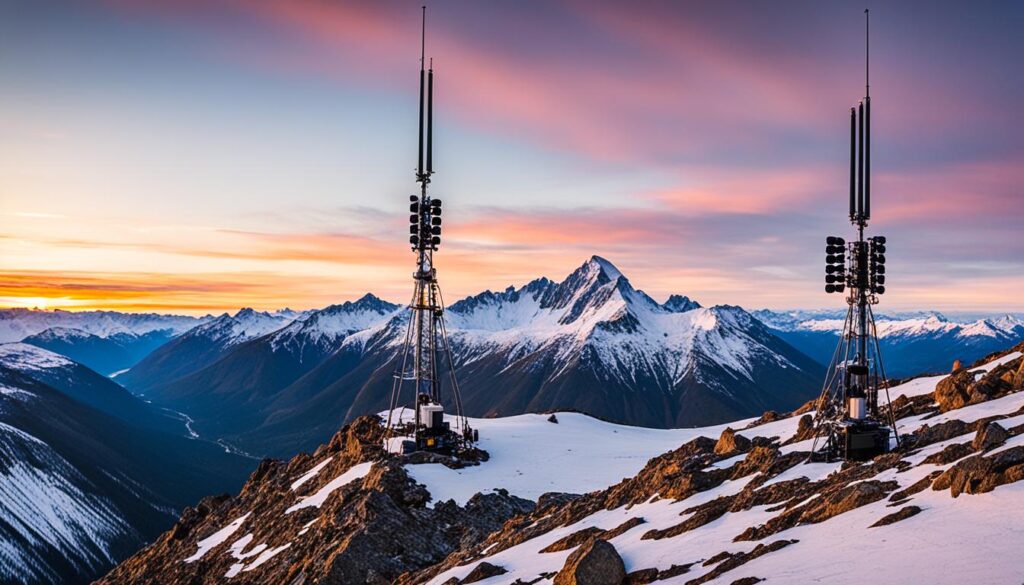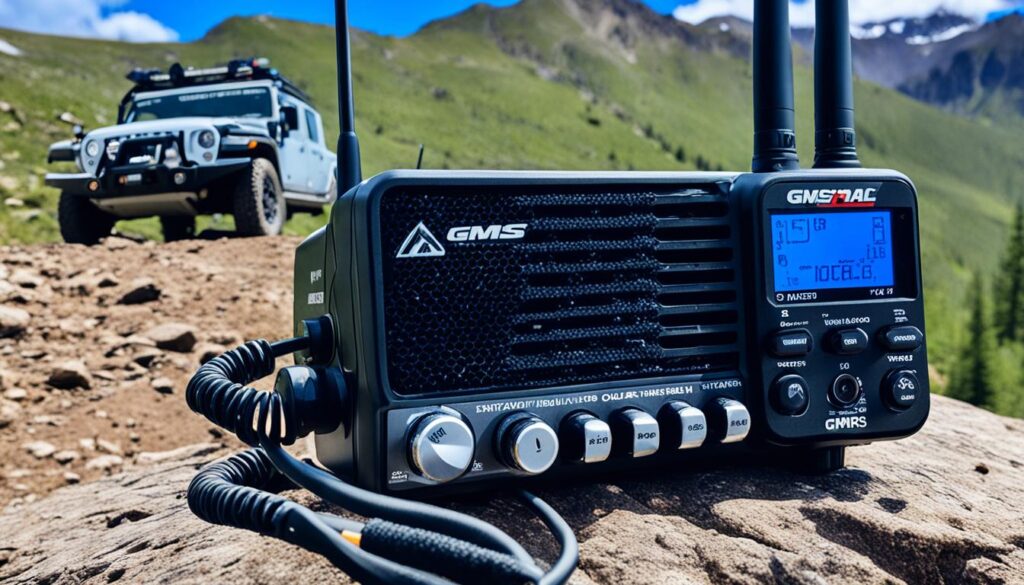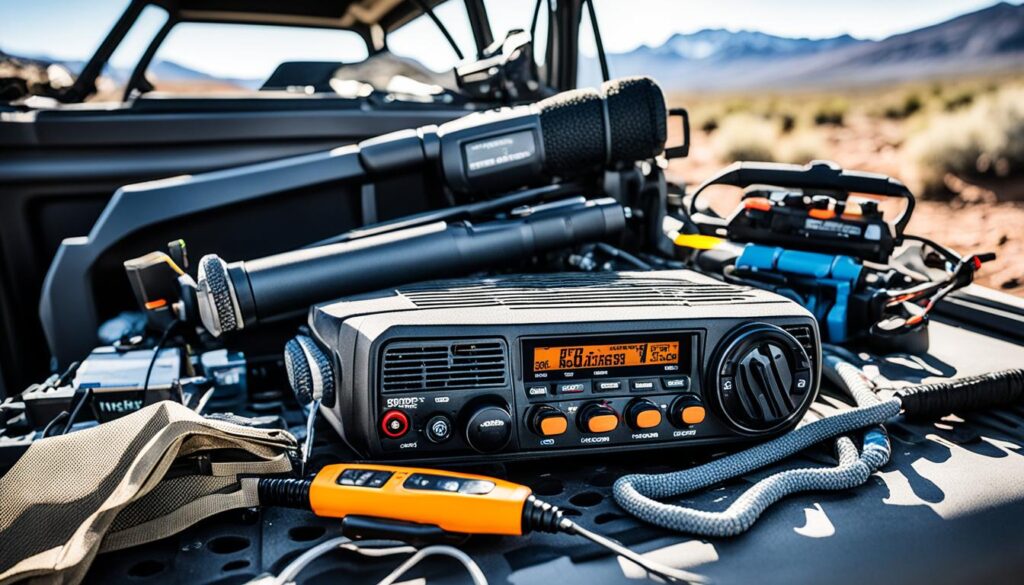Have you ever wondered why GMRS radio has become increasingly popular among overlanding enthusiasts in the US? What makes it stand out from other radio services like CB or FRS? Let’s explore the unique features and benefits that have made GMRS radio the go-to choice for off-road communication.
Key Takeaways:
- GMRS radio offers a set of features that make it ideal for off-road communication during overlanding adventures.
- It operates in the UHF band with 30 total channels, providing greater range and accessibility.
- GMRS radios require an FCC license to transmit, but obtaining one is easy and inexpensive.
- Choosing the right antenna is crucial to maximize the performance of a GMRS radio.
- GMRS radios can utilize repeaters to vastly increase communication range, making them even more valuable for overlanding.
Contents
The Benefits of GMRS for Off-Roaders
GMRS radios offer numerous benefits for off-roaders. Reliable communication is essential for safety and coordination during off-road trips, where cell phone coverage is often limited. GMRS radios provide a greater range than other short-range communication devices like FRS radios. The use of repeaters can further extend the range of GMRS radios, allowing for communication in remote areas where cell phone service is unavailable.
While GMRS radios require an FCC license to transmit, obtaining a license is easy and inexpensive. Once licensed, GMRS radios can be used by any family member within the licensed system, making it convenient for multiple people to communicate. The channelized system of GMRS radios also simplifies communication, as users can simply refer to channel numbers instead of specific frequencies. GMRS radios offer a wide range of channels, allowing for versatile communication options.
Benefits of GMRS for Off-Roaders:
- Extended Range: GMRS radios provide a greater range compared to other short-range communication devices, such as FRS radios. This makes them ideal for off-roaders who venture into remote areas with limited cell phone coverage.
- Repeater Capability: The use of repeaters can significantly extend the range of GMRS radios, enabling communication in areas where cell phone service is unavailable.
- FCC Licensing: While GMRS radios require an FCC license to transmit, obtaining a license is easy and inexpensive. Once licensed, any family member within the system can use the radios for communication.
- Convenience: GMRS radios utilize a channelized system, allowing users to communicate using channel numbers instead of specific frequencies. This simplifies communication and makes it easier to coordinate with other off-roaders.
- Versatile Communication: GMRS radios offer a wide range of channels, providing users with versatile communication options depending on their specific needs and requirements.
With the greater range, repeater capability, and convenient channelized system, GMRS radios are an excellent choice for off-roaders looking to stay connected and ensure their safety during off-road adventures.
Choosing the Right GMRS Radio
When it comes to selecting a GMRS radio, there are several important factors to consider. With a wide range of options available, from basic handheld radios to prosumer-grade devices with advanced features, making the right choice requires careful consideration of your specific needs.
One essential consideration is the radio’s features. GMRS radios come with a variety of functionalities, such as removable antennas that offer flexibility in different environments. Additionally, some radios have repeater capability, significantly extending communication range, making them ideal for overlanding adventures.
Another crucial factor to keep in mind is the radio’s durability and customization capabilities. Look for radios that can withstand rugged conditions and offer customization options to tailor the device to your specific preferences.
It’s also essential to consider the charging options available for the radio. Look for radios that offer convenient charging methods, such as USB charging, to ensure you can easily recharge the device during your outdoor excursions.
Reading GMRS radio reviews can be highly beneficial in making an informed decision. By exploring reviews from other users and experts, you can gain valuable insights into the performance, durability, and overall quality of different GMRS radios, helping you choose the best one for your needs.
Ultimately, the best GMRS radio for you will depend on your individual requirements and budget. Consider how you plan to use the radio, the features that are most important to you, and the level of customization and durability you desire. By carefully evaluating these factors, you can confidently select the GMRS radio that will enhance your overlanding experience.
Benefits of Choosing the Right GMRS Radio
- Reliable Communication: Choosing the right GMRS radio ensures consistent and clear communication, vital for safety and coordination during off-roading adventures.
- Extended Range: GMRS radios with repeater capability enable communication over vast distances, even in remote areas with limited cell phone coverage.
- Durability: Selecting a GMRS radio with robust construction ensures that it can withstand the rigors of off-road excursions.
- Customization: Some GMRS radios offer customization options so you can tailor the device to your specific preferences and needs.
- Convenient Charging: Look for GMRS radios that offer easy and flexible charging methods, such as USB charging, for hassle-free power replenishment during your overlanding trips.
“Choosing the right GMRS radio is essential for reliable communication, extended range, durability, customization, and convenient charging options.”
Antenna Importance for GMRS Radios
Choosing the right antenna is crucial for maximizing the performance of a GMRS radio. A high-quality antenna can significantly improve the range and signal quality of the radio.
There are various high dB gain GMRS-tuned antennas available, some of which require a ground plane like the metal roof of a vehicle. Proper mounting of the antenna is also important, considering the type of vehicle and the surface where it will be mounted.
Mounting the antenna as high as possible on the vehicle can greatly enhance communication range. Additionally, some GMRS radios allow for the connection of external antennas to further extend the range.
It’s essential to invest in a good antenna and ensure proper installation to optimize the performance of a GMRS radio.
Utilizing Repeaters for Extended Range
One of the key advantages of GMRS radios is the ability to utilize repeaters to greatly extend communication range. Repeaters receive radio transmissions on one frequency and then amplify and retransmit them on a different frequency. This can significantly increase the range of GMRS radios, especially in areas with obstructions like mountains or dense forests.
To utilize repeaters, GMRS radios need to be repeater-capable and have the necessary channel settings to transmit and receive on the input and output frequencies of the repeater. Choosing a GMRS radio with repeater capability is essential for those who want to take full advantage of the extended communication range offered by repeaters.
Repeater systems enable GMRS radios to overcome the limitations of line-of-sight communication. This is particularly useful for overlanding adventures that involve off-road travel in remote and rugged terrain. By utilizing repeaters strategically placed in elevated locations, overlanders can maintain extended communication range even in challenging environments.
“Repeaters are an invaluable tool for overlanders, as they allow for reliable long-range communication in areas where direct radio transmission is limited or blocked by natural obstacles.”
Accessing repeaters requires knowledge of GMRS radio channels and the input and output frequencies of the repeaters in the area. By using the right channels and properly configuring their radios, overlanders can stay connected with their group or emergency services over remarkable distances.

GMRS Radio Channel Settings
When programming a GMRS radio to work with repeaters, it is important to understand how to configure the channel settings. Each repeater has its own predefined input and output frequencies, and these frequencies must be programmed into the radio channels.
Here’s an example of the channel settings for a GMRS radio with repeater capability:
| Channel | Frequency (MHz) | Tone Mode | Tone Frequency (Hz) |
|---|---|---|---|
| Channel 1 | GMRS Repeater Input | Tone Squelch | 146.2 |
| Channel 2 | GMRS Repeater Output | Tone Squelch | 146.2 |
These are just example settings, and the actual frequencies and tones will vary depending on the repeater system being used. It is essential to research and obtain the correct channel settings for the repeater systems in the areas where overlanding adventures are planned.
By utilizing repeaters and configuring GMRS radios correctly, overlanders can enjoy significantly extended communication range, enhancing safety and coordination during their off-road journeys.
Other Communication Options for Overlanding
While GMRS radios have become increasingly popular among overlanders, it’s worth exploring other communication options to find the best fit for your needs. Let’s take a look at some alternatives:
Family Radio Service (FRS) Radios
FRS radios are a simple and affordable way to communicate over short distances. However, they have limited range and may not perform well in obstructed or mountainous terrain. Keep in mind their limitations when considering them for overlanding adventures.
Citizens Band (CB) Radios
CB radios have been a go-to choice for off-roaders and truckers for many years. They offer decent range but are limited by line-of-sight communication and may not be suitable for remote areas with obstacles. Their popularity has waned with the rise of other options.
Ham Radios
If you’re looking for longer-range communication, Ham radios are a popular choice. They provide extensive coverage and the ability to communicate through a network of repeaters. However, obtaining a license and setting them up might be more complex, so factor in the learning curve if considering Ham radios.
Cellular Communication Devices
Cell phones are the most common communication devices but may have limited coverage in remote areas. While they offer convenience, keep in mind that relying solely on cell phones may leave you without communication options in areas with weak or no service.
Satellite Communication Devices
Satellite communication devices, such as satellite phones and satellite communicators, offer global coverage and can be a reliable option for remote communication. However, they can be more expensive and require line-of-sight access to the sky. Consider their cost and usage requirements when evaluating satellite communication devices.
Remember, communication options for overlanding depend on individual needs, group size, and the locations where your adventures take you. Assess your requirements and choose the most appropriate communication system to ensure connectivity and safety during your off-road journeys.
To help you make an informed decision, it’s a good idea to read reviews on the best GMRS radios and other communication options available in the market. Balanced research will give you a comprehensive understanding of the features, pros, and cons of each device.
| Communication Option | Range | License Requirement | Pros | Cons |
|---|---|---|---|---|
| GMRS Radios | Medium to long-range, depending on the terrain and use of repeaters | Requires an FCC license | Versatile, access to repeaters, reliable off-road communication | License required, limited range without repeaters |
| FRS Radios | Short-range | No license needed | Simple and affordable | Limited range, may not perform well in obstructed or mountainous terrain |
| CB Radios | Medium-range, line-of-sight dependent | No license needed | Widely used, decent range within line-of-sight | Range limitations, line-of-sight dependent |
| Ham Radios | Long-range, can communicate through repeaters | Requires a Ham radio license | Extensive coverage, ability to transmit data | License and setup complexity |
| Cellular Communication Devices | Dependent on cell network coverage | No license needed | Convenient, widely used | May have limited coverage in remote areas |
| Satellite Communication Devices | Global coverage | No license needed | Reliable in remote areas, global coverage | Expensive, line-of-sight with the sky required |
Choosing the Right Communication System for Overlanding
When it comes to overlanding, choosing the right communication system is essential for staying connected and ensuring safety. Factors such as group size, planned activities, and destination play a crucial role in deciding which communication option is best suited for your needs.
Short-Range Communication Options
For larger groups traveling together over relatively short distances, short-range communication options like FRS (Family Radio Service) or GMRS (General Mobile Radio Service) radios are a great choice. These radios are simple to use, portable, and offer multiple channels for easy communication.
Long-Range Communication and Safety
In situations where longer-range communication or emergency assistance is required, Ham radios are preferred. Ham radios provide extensive coverage and the ability to transmit data, ensuring effective communication even in remote areas. However, it’s important to note that Ham radios require a license and may involve more complex setup procedures.
Individual vs. Group Communication
While cell phones are a practical option for individual communication, they may not be ideal for group communication during overlanding trips. Group communication systems like FRS and GMRS radios offer the convenience of simultaneous communication among multiple members.
Global Coverage and Emergency Situations
Satellite communication devices provide global coverage and the ability to contact emergency services from anywhere. However, they can be expensive and require line-of-sight with the sky. It’s crucial to prioritize safety and ensure that at least one long-range communication option is available in case of emergencies.
| Communication Option | Range | License Required | Group Communication | Emergency Coverage |
|---|---|---|---|---|
| FRS Radios | Short Range | No | Yes | Limited |
| GMRS Radios | Short to Medium Range | Yes | Yes | Limited |
| Ham Radios | Long Range | Yes | Yes | Extensive |
| Cell Phones | Short to Medium Range | No | No | Limited |
| Satellite Communication Devices | Global Coverage | No | No | Extensive |
Table: Comparison of Communication Options for Overlanding
By carefully considering the specific needs of your overlanding trip, you can choose the communication system that provides the best balance between range, ease of use, group communication, and emergency coverage. Remember, prioritizing safety and maintaining communication throughout your adventure is crucial.

Conclusion
GMRS radios have become increasingly popular among overlanding adventurers in the US. These radios offer a range of features that make them an ideal communication tool for off-road trips. Whether it’s coordinating with fellow travelers, navigating through remote areas, or seeking assistance in emergencies, GMRS radios provide reliable and effective communication.
Compared to other short-range communication devices like FRS radios, GMRS radios offer a greater range, allowing overlanders to stay connected in areas with limited cell phone coverage. By accessing repeaters, the range of GMRS radios can be extended even further, making them invaluable for off-road adventures.
When choosing a communication system for overlanding, it’s essential to consider individual needs, group size, and specific requirements. GMRS radios offer a unique combination of range, versatility, and repeater access, making them a suitable choice for many overlanders. However, it’s important to evaluate other communication options as well, such as FRS radios, Ham radios, cell phones, and satellite devices, to ensure the right system is chosen for each adventure.
Prioritizing communication and selecting the appropriate communication devices can enhance safety, connectivity, and peace of mind during off-road journeys. By utilizing GMRS radios, overlanders can enjoy the advantages of reliable and efficient communication, making their overlanding experiences more enjoyable and secure.
FAQ
What is GMRS radio?
GMRS (General Mobile Radio Service) is a radio service regulated by the FCC (Federal Communications Commission) in the United States. It offers a unique set of features that make it ideal for off-road communication.
How many channels does GMRS radio have?
GMRS radios have a total of 30 channels, each with varying power limitations. These radios operate in the UHF band around 462 MHz and 467 MHz.
Do I need a license to use GMRS radio?
Yes, a license is required to transmit on GMRS radio channels. However, obtaining a license is easy and inexpensive.
What features do GMRS radios offer?
GMRS radios offer analog FM voice operation, digital data transmission, and GPS location information capabilities.
What are the benefits of GMRS radios for off-roaders?
GMRS radios provide a greater range than other short-range communication devices, making them ideal for off-road trips where cell phone coverage is limited. They can also utilize repeaters to further extend communication range.
How do I choose the right GMRS radio?
When choosing a GMRS radio, consider factors such as the intended use, desired features, and budget. Reading GMRS radio reviews can also help in making an informed decision.
What is the importance of the antenna for GMRS radios?
The antenna plays a crucial role in maximizing the performance of a GMRS radio. Choosing a high-quality antenna and proper installation can significantly improve range and signal quality.
How can I utilize repeaters with GMRS radios?
To utilize repeaters, your GMRS radio needs to be repeater-capable and have the necessary channel settings to transmit and receive on the input and output frequencies of the repeater.
What are the other communication options for overlanding?
Other communication options for overlanding include FRS radios, CB radios, Ham radios, cell phones, and satellite communication devices. Each option has its own advantages and limitations.
How do I choose the right communication system for overlanding?
When choosing a communication system for overlanding, consider factors such as group size, intended destinations, and the types of activities planned. Evaluate the range, simplicity, and coverage of each option to meet your specific needs.






